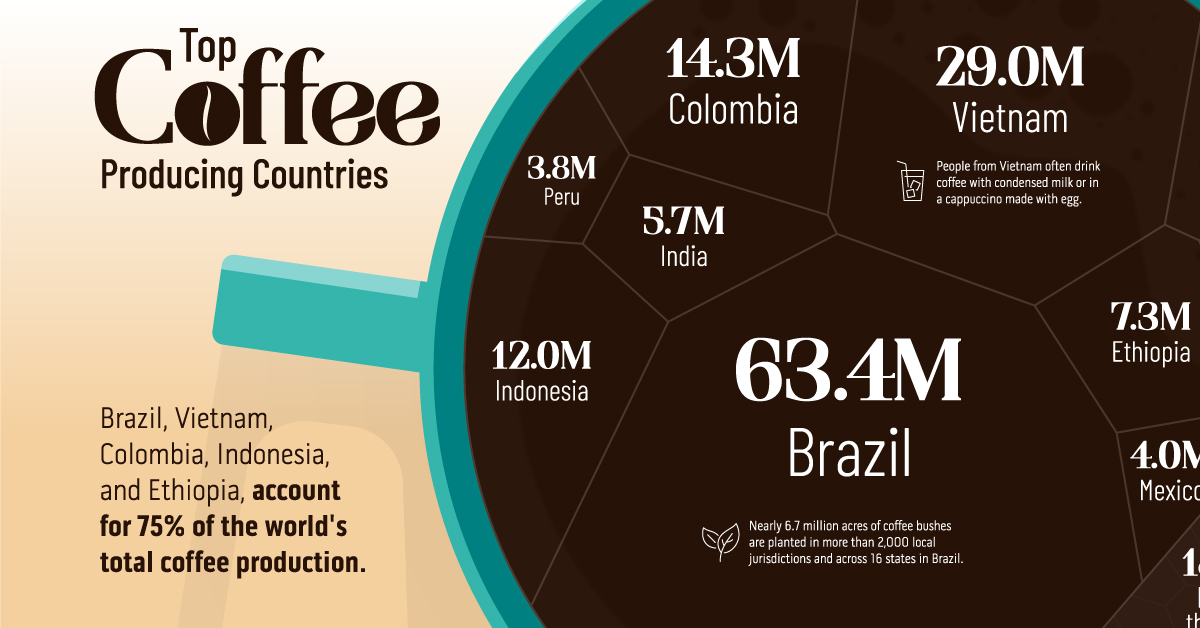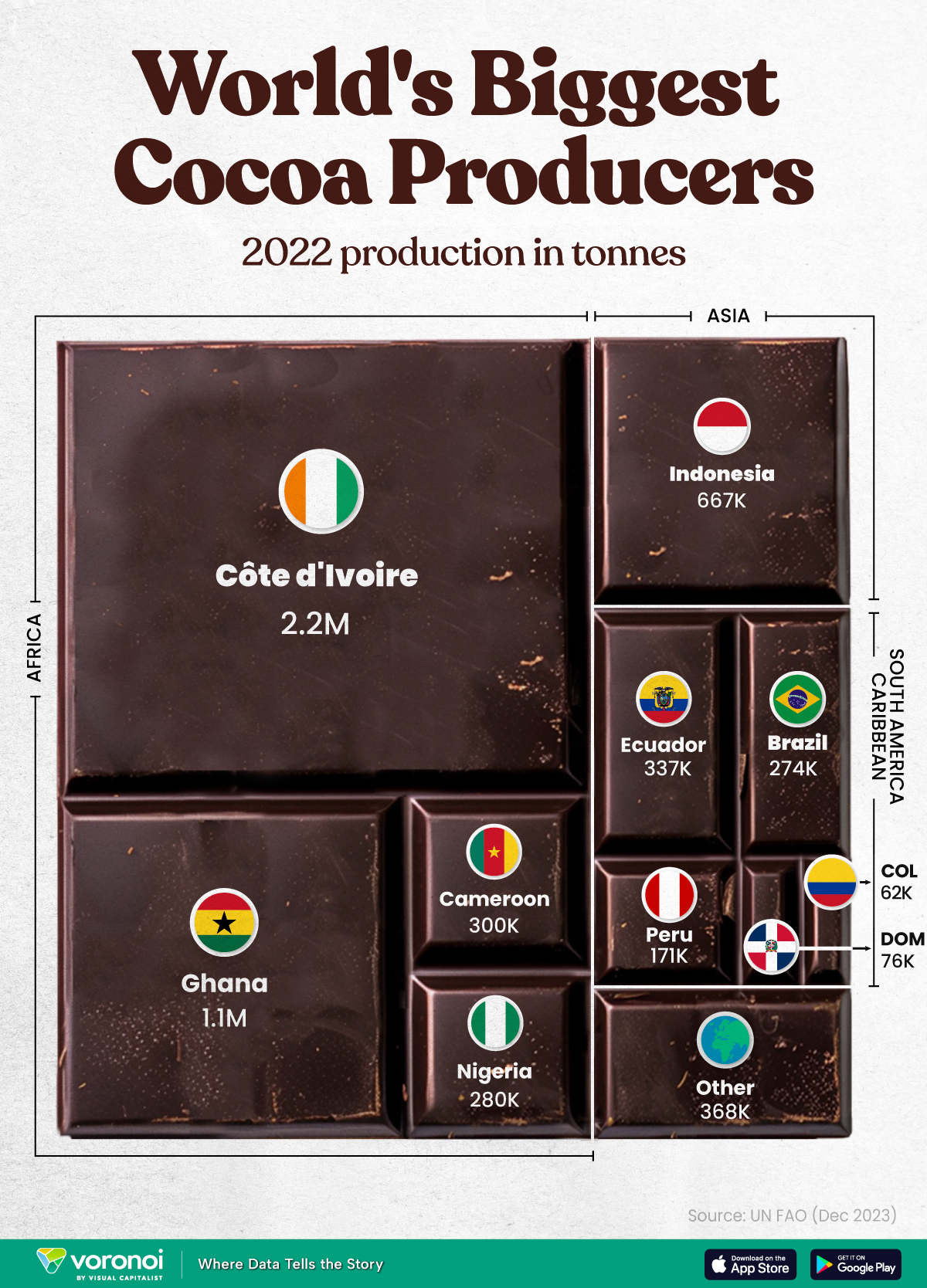Agriculture
The World’s Top Coffee Producing Countries
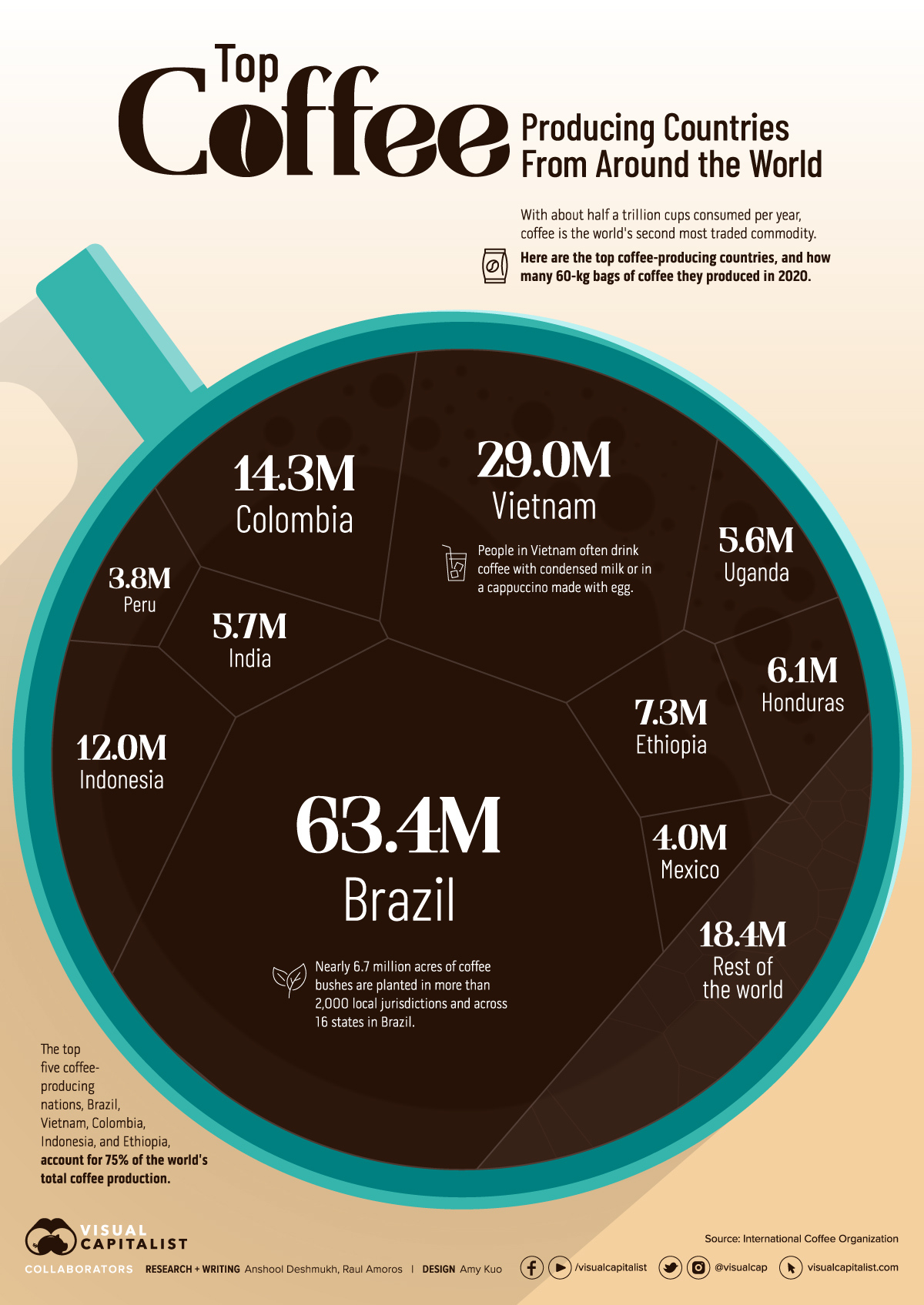
The World’s Top Coffee Producing Countries
In many cities around the world, there’s a café on every corner, so it comes as no surprise that coffee is one of the globes’ top commodities. As the third most consumed beverage globally, after water and tea, coffee beans are in high demand almost everywhere.
The top producing nations each produce billions of kilograms of coffee beans that find their way into the hands of eager consumers. According to the International Coffee Organization, a total of 169.6 million 60-kilogram bags of coffee were produced worldwide in 2020.
So, why does the world universally love coffee so much?
For The Love of Coffee
As most coffee lovers would tell you, drinking coffee is a complex and nuanced experience—there’s the rich aroma, the comforting warmth, and the loveliness of the ritual of sitting down with a fresh cup.
With the variety of ways it can be served and the jolt of caffeine it provides us, it’s not hard to see why the world loves its coffee. In fact, we love the beverage so much that humans have conditioned themselves to associate the bitter taste of coffee with a bout of energy and positive reinforcement.
So, where does the journey of each cup of joe originate? Let’s get to know the world’s top coffee producing countries.
The World’s Coffee Production Leaders
At the end of 2020, the top 10 biggest coffee-producing nations held 87% of the commodity’s market share.
Here is a list of the top 20 largest coffee-producing nations in the world:
| Rank | Country | Production in 2020 (Million 60-kg Bags) | Total Market Share |
|---|---|---|---|
| 1 | 🇧🇷 Brazil | 63.4 | 37.4% |
| 2 | 🇻🇳 Vietnam | 29.0 | 17.1% |
| 3 | 🇨🇴 Colombia | 14.3 | 8.4% |
| 4 | 🇮🇩 Indonesia | 12.0 | 7.1% |
| 5 | 🇪🇹 Ethiopia | 7.3 | 4.3% |
| 6 | 🇭🇳 Honduras | 6.1 | 3.6% |
| 7 | 🇮🇳 India | 5.7 | 3.4% |
| 8 | 🇺🇬 Uganda | 5.6 | 3.3% |
| 9 | 🇲🇽 Mexico | 4.0 | 2.4% |
| 10 | 🇵🇪 Peru | 3.8 | 2.2% |
| 11 | 🇬🇹 Guatemala | 3.7 | 2.2% |
| 12 | 🇳🇮 Nicaragua | 2.7 | 1.6% |
| 13 | 🇨🇮 Côte d'Ivoire | 1.8 | 1.1% |
| 14 | 🇨🇷 Costa Rica | 1.5 | 0.9% |
| 15 | 🇹🇿 Tanzania | 0.9 | 0.5% |
| 16 | 🇰🇪 Kenya | 0.7 | 0.4% |
| 17 | 🇵🇬 Papua New Guinea | 0.7 | 0.4% |
| 18 | 🇱🇦 Laos | 0.6 | 0.4% |
| 19 | 🇸🇻 El Salvador | 0.6 | 0.4% |
| 20 | 🇹🇭 Thailand | 0.6 | 0.4% |
While some of the world’s top coffee-producing nations are well known, others may come as a surprise. More than 70 countries produce coffee, but the majority of global output comes from just the top five producers: Brazil, Vietnam, Colombia, Indonesia, and Ethiopia.
Meet the Top Coffee Producing Countries
1. Brazil
Brazil is a true powerhouse of coffee production. The country single-highhandedly produces nearly 40% of the world’s coffee supply.
Many areas in Brazil have a climate perfectly conducive to coffee farming. Coffee plantations cover about 27,000 square kilometers of Brazil, with the majority located in Minas Gerais, São Paulo, and Parana.
Brazil distinguishes itself from most other coffee-producing nations by drying the coffee cherries in the sun (unwashed coffee) rather than washing them.
The country is so influential to coffee production that the 60-kilogram burlap bags historically used to export beans from Brazil are still the worldwide standard for measuring production and trade.
2. Vietnam
Vietnam found a niche in the international market by focusing primarily on the less-expensive Robusta bean. Robusta beans can have up to twice as much caffeine as Arabica beans, giving the coffee a more bitter taste.
Though coffee has been grown in the region for well over a century, production skyrocketed through the 1990s after Vietnam’s communist government introduced economic reforms (known as Đổi Mới).
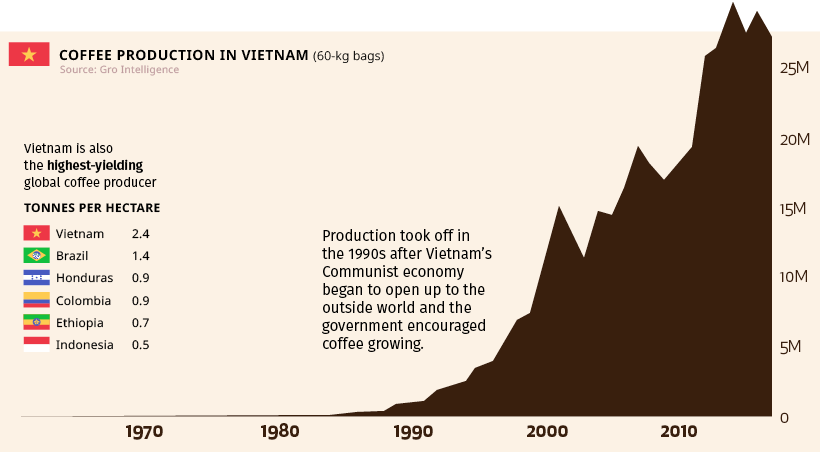
Today, Vietnam accounts for more than 40% of the world’s Robusta bean production.
Coffee cultivation in Vietnam is also extremely productive. The country’s coffee yields are considerably higher than other top coffee-producing countries.
3. Colombia
A popular advertising campaign featuring a fictional coffee farmer named Juan Valdez helped brand Colombia as one of the most famous coffee-producing nations. A coveted drink of choice, Colombian coffee is prized for its aromatic, mild, and fruity flavors.
4. Indonesia
Some of the rarest coffees in the Western world originate in Indonesia, including Kopi Luwak—a type of bean that has been eaten and defecated by the Asian palm civet. Coffee made from these coffee beans might cost you anywhere between $35 to $100 per cup.
5. Ethiopia
Known for its full-flavored, down-to-earth, and full-bodied coffee beans, Ethiopia is the country that gave us the Arabica coffee plant. Today this type of coffee is considered to be the most widely sold in cafes and restaurants across the world.
All of these top producing countries are found in the so-called “Bean Belt”, which is located between the Tropic of Cancer and the Tropic of Capricorn.
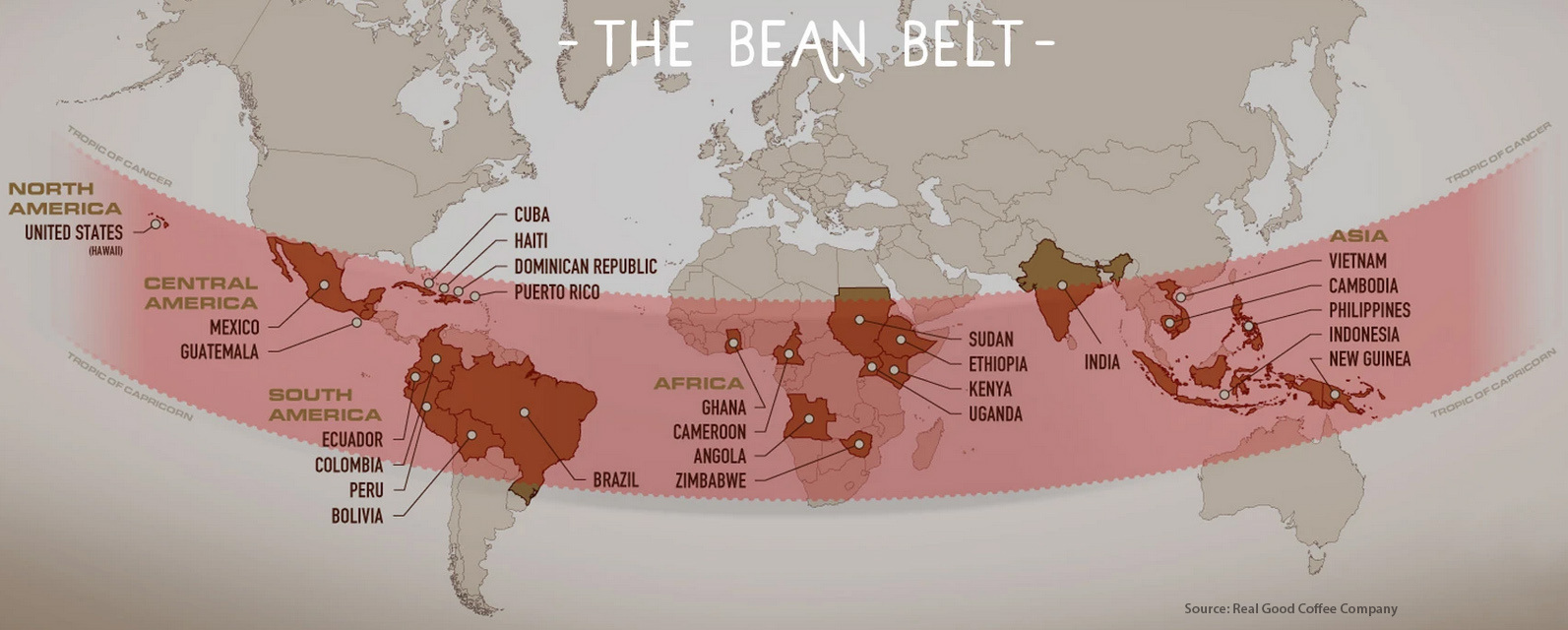
The Future of Coffee Production
With global temperatures on the rise, good coffee may become increasingly challenging to grow. To future-proof good and continued growth of coffee beans, finding newer and hybrid blends of coffee beans is essential.
Several studies and research missions have found wild species of coffee growing off the coast of Côte d’Ivoire and in certain regions of Sierra Leone, which could be the answer to our coffee production problems. Coffee from these coffee plants tasted similar to the famous Arabica bean and also grew at higher temperatures.
Though the future of coffee production around the world is somewhat uncertain, our collective love of the morning cup of coffee will drive innovative solutions, even in the face of changing climate patterns.
Markets
The World’s Top Cocoa Producing Countries
Here are the largest cocoa producing countries globally—from Côte d’Ivoire to Brazil—as cocoa prices hit record highs.
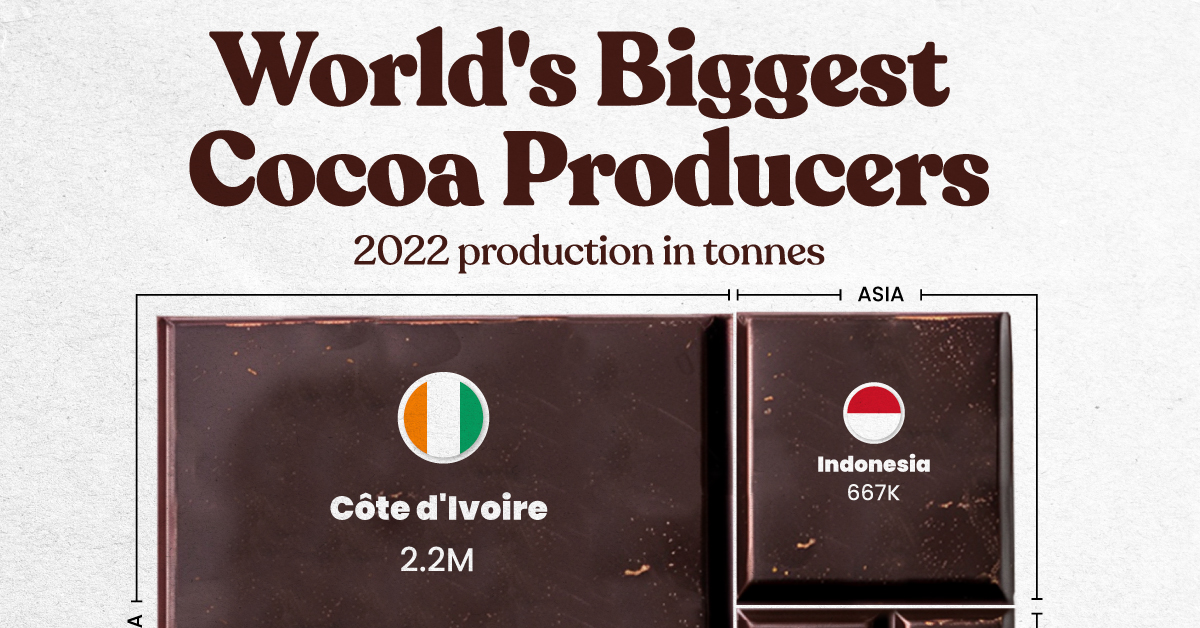
The World’s Top Cocoa Producing Countries
This was originally posted on our Voronoi app. Download the app for free on iOS or Android and discover incredible data-driven charts from a variety of trusted sources.
West Africa is home to the largest cocoa producing countries worldwide, with 3.9 million tonnes of production in 2022.
In fact, there are about one million farmers in Côte d’Ivoire supplying cocoa to key customers such as Nestlé, Mars, and Hershey. But the massive influence of this industry has led to significant forest loss to plant cocoa trees.
This graphic shows the leading producers of cocoa, based on data from the UN FAO.
Global Hotspots for Cocoa Production
Below, we break down the top cocoa producing countries as of 2022:
| Country | 2022 Production, Tonnes |
|---|---|
| 🇨🇮 Côte d'Ivoire | 2.2M |
| 🇬🇭 Ghana | 1.1M |
| 🇮🇩 Indonesia | 667K |
| 🇪🇨 Ecuador | 337K |
| 🇨🇲 Cameroon | 300K |
| 🇳🇬 Nigeria | 280K |
| 🇧🇷 Brazil | 274K |
| 🇵🇪 Peru | 171K |
| 🇩🇴 Dominican Republic | 76K |
| 🌍 Other | 386K |
With 2.2 million tonnes of cocoa in 2022, Côte d’Ivoire is the world’s largest producer, accounting for a third of the global total.
For many reasons, the cocoa trade in Côte d’Ivoire and Western Africa has been controversial. Often, farmers make about 5% of the retail price of a chocolate bar, and earn $1.20 each day. Adding to this, roughly a third of cocoa farms operate on forests that are meant to be protected.
As the third largest producer, Indonesia produced 667,000 tonnes of cocoa with the U.S., Malaysia, and Singapore as major importers. Overall, small-scale farmers produce 95% of cocoa in the country, but face several challenges such as low pay and unwanted impacts from climate change. Alongside aging trees in the country, these setbacks have led productivity to decline.
In South America, major producers include Ecuador and Brazil. In the early 1900s, Ecuador was the world’s largest cocoa producing country, however shifts in the global marketplace and crop disease led its position to fall. Today, the country is most known for its high-grade single-origin chocolate, with farms seen across the Amazon rainforest.
Altogether, global cocoa production reached 6.5 million tonnes, supported by strong demand. On average, the market has grown 3% annually over the last several decades.
-

 Markets1 week ago
Markets1 week agoU.S. Debt Interest Payments Reach $1 Trillion
-

 Business2 weeks ago
Business2 weeks agoCharted: Big Four Market Share by S&P 500 Audits
-

 Markets2 weeks ago
Markets2 weeks agoRanked: The Most Valuable Housing Markets in America
-

 Money2 weeks ago
Money2 weeks agoWhich States Have the Highest Minimum Wage in America?
-

 AI2 weeks ago
AI2 weeks agoRanked: Semiconductor Companies by Industry Revenue Share
-

 Markets2 weeks ago
Markets2 weeks agoRanked: The World’s Top Flight Routes, by Revenue
-

 Demographics2 weeks ago
Demographics2 weeks agoPopulation Projections: The World’s 6 Largest Countries in 2075
-

 Markets2 weeks ago
Markets2 weeks agoThe Top 10 States by Real GDP Growth in 2023




